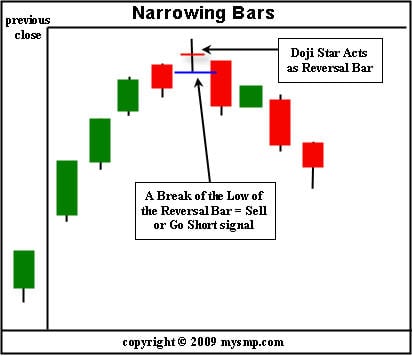
Our next day trading strategy stipulates that a series of consecutively smaller ranging bars occurring in a single direction will lead to a reversal when the proper conditions are met. This setup can be taken with or without a gap and is a counter trade. Just as with the opening reversal gap fill strategy, this trading setup goes counter to the early morning activity and should be taken with caution and regard for the overall market condition as you are ready to place the trade. The best trades are the ones which are taken in the direction of the daily trend and also have the broad market indicators at their back. It is important to note that in a very strong trend, it is not advisable to take this trade. Many times, these breakdowns or breakouts will be shakeouts for a move back in the primary trend. Additionally, high volume tops have a fairly high chance of being retested (forming a double top) before they move lower. If you get stopped out on your first position, it is acceptable to take a second position if a double top forms.
The Setup
The setup is fairly simple; we are looking for a general series of consecutively smaller bars, typically between 4 and 6, beginning with the opening 5 minute bar, ending with a reversal bar. A reversal bar may come in the form of a hammer, doji, or even a bullish or bearish engulfing bar. I like to see heavy volume on the reversal as it indicates exhaustion or it can indicate a heavy battle. If the battle is lost by the bulls in the uptrend, a move below the reversal bar will indicate a change in trend. As usual, it is important to watch the action on the time and sales windowto confirm the selling through a support area.
Money Management
You can immediately place your stop above the high of the reversal bar and use the 10 period EMA to walk the stock down. From experience, this day trading setup is not one that a trader should expect large gains from. In fact, I have seen extremely fast gains come out of this position as traders will pile on as profit taking is due and no one wants to give up much of their gains. However, Fibonacci retracement levels should be looked at carefully; especially the 38%, 50% and 62% retracement areas. This is typically where these pullbacks will find support or resistance (in the case of a long signal) and move back higher. It would be prudent to at least take a portion of the position off and carefully watch the balance as these fib numbers are hit.


does your platform have range bars?
does your platform have range bars?
Tradingsim displays chart data in candlestick, OHLC, Line and Bar. You of course can use candlesticks and OHLC to identify range bars.